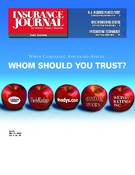Many carriers, especially commercial lines carriers, rely on independent agencies to sell and service policyholders. The agency typically owns and maintains the relationship with the insured. Carriers that maximize agent productivity and provide them with resources for more efficiently processing policy applications will garner a more loyal and profitable agency base, ultimately gaining an advantage over their competition.
Recent studies show that agents have the skills and desire to handle more advanced technology, want applications processed in real-time (or near real-time), and prefer working with technologically progressive carriers. They also desire rapid underwriting decisions.
New and sophisticated technology offerings are available to carriers that enable them to provide agents with immediate and accurate underwriting decision guidance and support. Providing underwriting decision-making technology to agents streamlines communication with the carrier and enables the agent to take a broader role in the policy processing lifecycle. As agents are, in essence, first line underwriters, it makes sense to equip them with a sophisticated underwriting tool for a faster and more profitable outcome.
More value to the agency role
The longer it takes to fully process an application, the greater the likelihood that the applicant will find another carrier. In a recent survey, Celent reported that underwriting speed is the third highest priority for property/casualty agents behind product pricing and product features. This makes speed the most important element of the carrier/agency relationship that is system and/or process related.
As the agent is responsible for interfacing with the policyholder, the most effective way to ensure the fastest application process is to expand the role of the agent to include underwriting tasks, and to use technology to enhance their ability to perform this role. Agents with the ability to screen policy applications will be more productive and profitable.
Independent agents use their experience to determine the appropriate carrier for a particular risk. They make a decision about which carrier will accept the business and then write the business at the best price.
Agents also tend to send business to carriers that they deem “easy” to work with, i.e. carriers that have efficient application processes and quick underwriting responses. Traditional pre-screening methods fall short of delivering the quick and accurate risk assessments that predictive underwriting systems can make by analyzing all risk factors simultaneously and in real-time.
Giving agents access to Web-based predictive underwriting systems enables them to accurately assess risk prior to sending an application through a lengthy and costly underwriting process. Empowering agents with accurate and consistent risk assessment capabilities will dramatically speed up the application process and improve agent productivity, ultimately bringing more revenue to carriers. Not only will empowering agents with underwriting decision-making tools improve carrier/agency relationships and profitability, but it will ultimately improve carrier efficiency as well.
If a carrier can decrease the underwriting cycle time and eliminate underwriting touch points, underwriting throughput will improve as well as carrier expense ratios. A Web-based predictive underwriting system that is pushed out to agents can effectively screen a certain percentage of “no-brainer” accept and reject decisions leaving the more complicated risks to underwriters.
The chart on this page illustrates how a predictive underwriting system helps agents make accept and reject policy decisions, quicken underwriting response time and refer complicated decisions to underwriters.
Sophisticated pattern recognition and predictive underwriting software exists for insurance carriers that enables them to lower loss ratios and improve profitability through better risk selection, tier placement, risk scoring, and more accurate pricing-to-risk. This predictive underwriting technology enables underwriters to instantaneously assess a complete policy risk using all potential risk factors concurrently. The technology is rooted in the same family of science used for credit card fraud detection, but is tuned and tailored for assessing the profit potential of an individual risk, based on past experience of like policies.
Predictive underwriting technology is much more than a modeling tool. It is a powerful tool that gives insurance carriers an application that makes highly accurate underwriting decisions on a unit at risk and/or policy basis.
Underwriters no longer have to rely on underwriting guidelines based on subjective experience to make risk assessments; rather, they can take advantage of multivariate, statistical analysis of the risk characteristics. Predictive underwriting technology builds company specific risk models based upon all of a company’s historical policy, claims, underwriting, and loss control data and incorporates appropriate external data sources for improved predictions. The system then produces risk recommendations for new and renewal policies. The technology can also be used to assess entire books of business prior to an agency moving it to another carrier with different underwriting guidelines.
A Web interface to the predictive underwriting system gives agents the ability to obtain instant accept, reject, or refer decisions on policies. When a predictive underwriting system is brought to the agent desktop, agents become front-line underwriters by performing all the necessary application functions including pricing and binding policies (to the degree of their authority). Carrier underwriters only need to intervene for more complicated policies the system refers.
For those policies the system rejects, agents can use an ‘Explain’ feature that will query the risk model and produce reason codes for the rejection. The Explain feature will also provide the agent with factors that may be changed to make the risk acceptable i.e. lowering limits or increasing deductibles.
Regardless of industry, the first rule of sales is, “know the customer.” Inherent in their capabilities, predictive underwriting applications uncover the qualities that make a client a likely profitable or unprofitable risk. As a result, predictive underwriting technology can effortlessly sift through masses of target customer data in order to highlight those policyholders likely to be profitable.
Predictions can be used for marketing purposes also—new profitable niches or demographics can be identified or uncovered by the agent or carrier. Carriers can pass information to the agent so they can better target applicants that they know will be accepted by the carrier.
Paperwork and processes weigh down carriers and agents alike. Today’s sophisticated predictive underwriting systems can streamline the process while providing accurate, consistent underwriting decision support. Agencies and carriers both win. Ultimately, agents and carriers alike will gain a competitive edge and profitability will be enhanced.
Dax Craig co-founded Valen Technologies in 2002. Prior to Valen, Craig founded and served as CEO of Xertex Technologies Inc., a wireless technology an antenna company, from 1995 to 2000. In 2000, he sold Xertex to Centurion Wireless Technologies Inc. a leading global provider of antennas for wireless communications.
Topics InsurTech Carriers Agencies Profit Loss Underwriting Tech
Was this article valuable?
Here are more articles you may enjoy.


 10,000 Travelers Employees Get AI Assistants Via Anthropic Partnership
10,000 Travelers Employees Get AI Assistants Via Anthropic Partnership  Adjusters Launch ‘CarFax for Insurance Claims’ to Vet Carriers’ Damage Estimates
Adjusters Launch ‘CarFax for Insurance Claims’ to Vet Carriers’ Damage Estimates  Consumer Acceptance of Telematics Widens, Says Survey
Consumer Acceptance of Telematics Widens, Says Survey  Florida Lawmakers Ready for Another Shot at Litigation Funding Limits
Florida Lawmakers Ready for Another Shot at Litigation Funding Limits 


